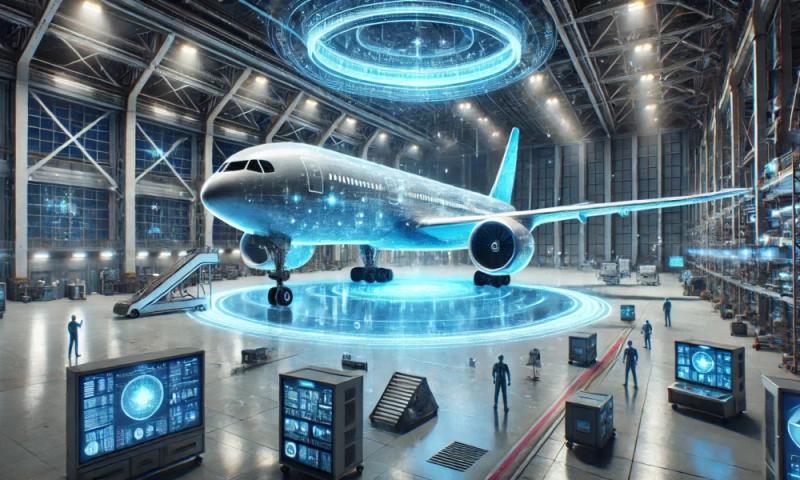The integration of AI in hypersonic testing environments is revolutionizing the aerospace industry. This transformative technology is not only enhancing the efficiency of tests but also ensuring accuracy and safety in environments that are inherently challenging. As the aerospace sector continues to push the boundaries of speed and technology, the role of AI becomes increasingly crucial in managing the complexities involved in hypersonic testing.

The Importance of Hypersonic Testing
Hypersonic testing is a critical component in the development and validation of aircraft and spacecraft that travel at speeds greater than Mach 5. These tests are essential for ensuring the structural integrity and performance of vehicles under extreme conditions. The challenges associated with such tests include high temperatures, pressure variations, and the need for precise data collection and analysis.
How AI Enhances Hypersonic Testing
AI in hypersonic testing environments plays a pivotal role in data analysis and decision-making. By utilizing advanced algorithms, AI systems can process vast amounts of data collected during tests to identify patterns and predict outcomes. This capability allows engineers to make informed decisions quickly, which is crucial in a field where time and accuracy are of the essence.
Data Collection and Analysis
One of the primary applications of AI in hypersonic testing is in the collection and analysis of data. Sensors placed on hypersonic vehicles collect data on temperature, pressure, and structural integrity. AI systems then analyze this data in real-time, providing engineers with insights into the performance of the vehicle.
Predictive Maintenance
Predictive maintenance is another area where AI proves invaluable. By analyzing data trends, AI can predict potential failures or maintenance needs before they occur, reducing downtime and ensuring the safety of hypersonic vehicles.
AI’s Role in Safety and Efficiency
Safety is a paramount concern in hypersonic testing. AI systems help enhance safety by providing real-time monitoring and alerts. This capability allows engineers to respond quickly to any anomalies, preventing accidents and ensuring the safety of both the vehicle and the testing personnel.
Real-Time Monitoring
Real-time monitoring enabled by AI is a game-changer in hypersonic testing. With the ability to monitor all aspects of the test in real-time, engineers can make adjustments on-the-fly, improving the efficiency and outcome of the tests.
Accident Prevention
By analyzing data and predicting potential issues, AI systems can prevent accidents before they happen. This proactive approach not only saves lives but also reduces costs associated with accidents and equipment damage.
Challenges in Implementing AI in Hypersonic Testing
Despite its benefits, the implementation of AI in hypersonic testing environments is not without challenges. These include the need for advanced algorithms, the integration of AI with existing systems, and the requirement for ongoing training and development of AI models.
Algorithm Development
Developing algorithms capable of handling the complexities of hypersonic testing is a significant challenge. These algorithms must be able to process large amounts of data quickly and accurately, making the development process both time-consuming and resource-intensive.
System Integration
Integrating AI with existing testing systems can also pose challenges. Compatibility issues and the need for seamless communication between AI systems and other testing equipment are critical for the successful implementation of AI in hypersonic testing environments.
The Future of AI in Hypersonic Testing
The future of AI in hypersonic testing looks promising. As technology advances, the capabilities of AI systems will continue to grow, making hypersonic testing more efficient and accurate. This evolution will enable the aerospace industry to develop faster, safer, and more reliable vehicles.
Continuous Improvement
The continuous improvement of AI technologies will lead to more sophisticated testing environments. This evolution will allow for the testing of even more advanced hypersonic vehicles, pushing the boundaries of what is possible in the aerospace industry.
Global Collaboration
Global collaboration in the development of AI technologies will further enhance hypersonic testing. By sharing knowledge and resources, countries can work together to overcome the challenges associated with hypersonic testing and develop cutting-edge technologies.
Conclusion
In conclusion, the integration of AI in hypersonic testing environments is a transformative development in the aerospace industry. By enhancing data analysis, predictive maintenance, safety, and efficiency, AI is paving the way for the future of hypersonic testing. Despite the challenges, the continued advancement of AI technologies promises a future where hypersonic testing is safer, more efficient, and more accurate than ever before.

FAQs
What is hypersonic testing?
Hypersonic testing involves the evaluation of vehicles that travel at speeds greater than Mach 5. These tests assess the structural integrity and performance of the vehicles under extreme conditions.
How does AI enhance hypersonic testing?
AI enhances hypersonic testing by providing real-time data analysis, predictive maintenance, and improved safety measures. This integration helps engineers make informed decisions quickly, improving the efficiency and accuracy of tests.
What are the challenges of implementing AI in hypersonic testing?
Challenges include the development of advanced algorithms, integration with existing systems, and the need for ongoing training and development of AI models.
For more insights on AI-driven aerospace innovations, explore this resource.
To delve deeper into related topics, you can check out more on AI in zero gravity robotics and AI in satellite payload analysis for further exploration.

